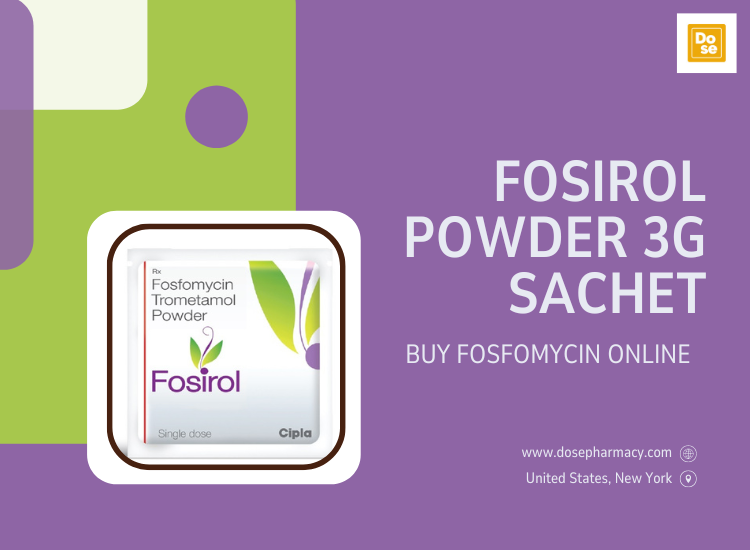Urinary tract infections (UTIs) are a persistent global health concern, affecting millions of people annually. While women are disproportionately impacted, UTIs also pose significant health risks to men, children, and the elderly. The increasing prevalence of antimicrobial resistance has further complicated the treatment landscape, making effective therapeutic options a priority. Among the array of antibiotics available, fosfomycin 3gm sachet stands out as a versatile and potent option for treating UTIs. However, its utility extends far beyond this scope. In this blog, we will explore fosfomycin’s mechanism of action, its efficacy in treating UTIs, and its potential applications in combating other bacterial infections.
Understanding Fosfomycin
Fosfomycin is an old antibiotic with renewed importance in the era of antimicrobial resistance. It was discovered in the 1960s from strains of Streptomyces fradiae. Classified as a phosphonic acid derivative, fosfomycin boasts a unique mode of action, making it highly effective against a range of bacterial pathogens. Unlike many other antibiotics, it inhibits the initial step of bacterial cell wall synthesis by targeting the enzyme MurA (UDP-N-acetylglucosamine enolpyruvyl transferase). This novel mechanism allows fosfomycin to retain efficacy against many multidrug-resistant (MDR) bacteria.
Fosfomycin is available in both oral and intravenous forms, which enhances its utility for outpatient and inpatient settings. In most cases, it is well-tolerated, with minimal side effects, making it a preferred option for diverse patient populations.
Fosfomycin and Urinary Tract Infections
UTIs, whether uncomplicated or complicated, are among the most common infections worldwide. Common culprits include Escherichia coli, Klebsiella pneumoniae, and other Gram-negative bacteria. Alarmingly, many of these pathogens have developed resistance to first-line antibiotics, such as trimethoprim-sulfamethoxazole, ciprofloxacin, and nitrofurantoin.
Why Fosfomycin?
Fosfomycin has emerged as a game-changer for treating uncomplicated UTIs, particularly in outpatient settings. Its oral formulation, administered as a single 3-gram dose, ensures high patient compliance. Once ingested, fosfomycin achieves high urinary concentrations, maintaining its bactericidal activity for up to 48 hours. This is especially beneficial for individuals who struggle to adhere to longer antibiotic regimens.
Efficacy Against Resistant Strains
Studies demonstrate fosfomycin’s efficacy against extended-spectrum beta-lactamase (ESBL)-producing E. coli, a pathogen notorious for its resistance to conventional antibiotics. Even carbapenem-resistant strains, which pose a grave public health challenge, show susceptibility to fosfomycin in many cases.
Safety Profile
Fosfomycin’s safety profile is another major advantage. It is generally well-tolerated, with mild gastrointestinal side effects like diarrhea being the most commonly reported adverse events. Its single-dose regimen minimizes the risk of adverse reactions, making it an ideal choice for pregnant women and older adults with uncomplicated UTIs.
Beyond UTIs: Fosfomycin’s Expanding Horizons
While fosfomycin is primarily associated with UTI management, its potential extends far beyond. Let’s delve into its emerging roles in treating other infections:
1. Multidrug-Resistant Infections
The rise of MDR pathogens has necessitated the repurposing of older antibiotics like fosfomycin. It is available at online pharmacy. Its ability to disrupt bacterial cell wall synthesis makes it effective against Gram-positive and Gram-negative bacteria, including methicillin-resistant Staphylococcus aureus (MRSA) and vancomycin-resistant enterococci (VRE).
2. Respiratory Infections
In combination with other antibiotics, fosfomycin shows promise in treating complicated respiratory infections caused by MDR bacteria. Although more research is needed, its role as an adjunct therapy is gaining attention.
3. Bone and Joint Infections
Fosfomycin’s excellent tissue penetration, particularly in bone, has made it a viable option for treating osteomyelitis and prosthetic joint infections. These infections are often caused by biofilm-forming bacteria, which are notoriously difficult to eradicate. Fosfomycin’s ability to penetrate biofilms offers a significant advantage.
4. Sepsis and Bloodstream Infections
Severe infections, such as sepsis, caused by MDR pathogens have limited treatment options. Intravenous fosfomycin, often used in combination therapy, has demonstrated efficacy in these life-threatening situations.
Fosfomycin in Combination Therapy
One of the most intriguing aspects of fosfomycin is its compatibility with other antibiotics. Combination therapy is often used to enhance its effectiveness, especially against MDR pathogens. For example:
- Fosfomycin + Carbapenems: Effective against carbapenem-resistant Klebsiella pneumoniae.
- Fosfomycin + Linezolid: Shows potential in treating VRE infections.
- Fosfomycin + Colistin: An option for severe MDR Gram-negative infections.
Combination therapy reduces the likelihood of resistance development and broadens the antibacterial spectrum, making fosfomycin an invaluable tool in the fight against MDR infections.
Challenges and Limitations
Despite its advantages, fosfomycin is not without limitations. These include:
- Emerging Resistance: Prolonged or inappropriate use can lead to resistance, particularly when used as monotherapy.
- Limited Availability: In some regions, fosfomycin is not widely available, restricting its use.
- Insufficient Data: While promising, more clinical trials are needed to establish fosfomycin’s efficacy in treating non-UTI infections.
Addressing these challenges requires judicious antibiotic stewardship, increased accessibility, and further research.
Future Directions
The renewed interest in fosfomycin highlights its potential as a cornerstone in combating antibiotic resistance. Ongoing research aims to:
- Expand its indications beyond UTIs.
- Optimize combination therapies for severe infections.
- Develop strategies to mitigate resistance development.
Additionally, the pharmaceutical industry is exploring innovative formulations, such as fosfomycin-loaded nanoparticles, to improve its delivery and efficacy.
Conclusion
Fosfomycin is more than just a treatment for urinary tract infections; it is a versatile weapon in the arsenal against antibiotic-resistant bacteria. Its unique mechanism of action, excellent safety profile, and efficacy against MDR pathogens underscore its importance in modern medicine. As antimicrobial resistance continues to rise, the role of fosfomycin is likely to expand, offering hope in the battle against some of the most challenging infections. By prioritizing research, accessibility, and responsible use, we can harness the full potential of this remarkable antibiotic.
In a world where antibiotic options are dwindling, fosfomycin stands as a beacon of promise—proving that sometimes, the old can indeed become new again.



